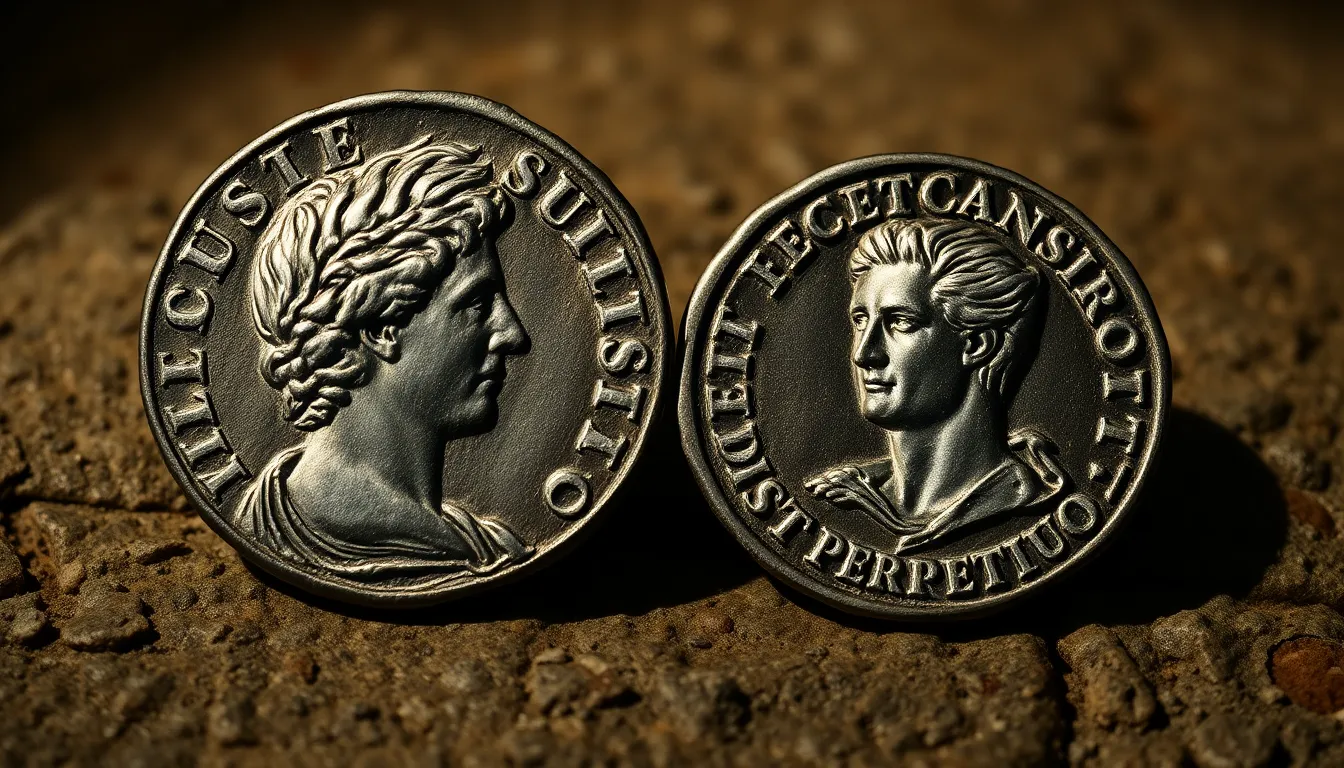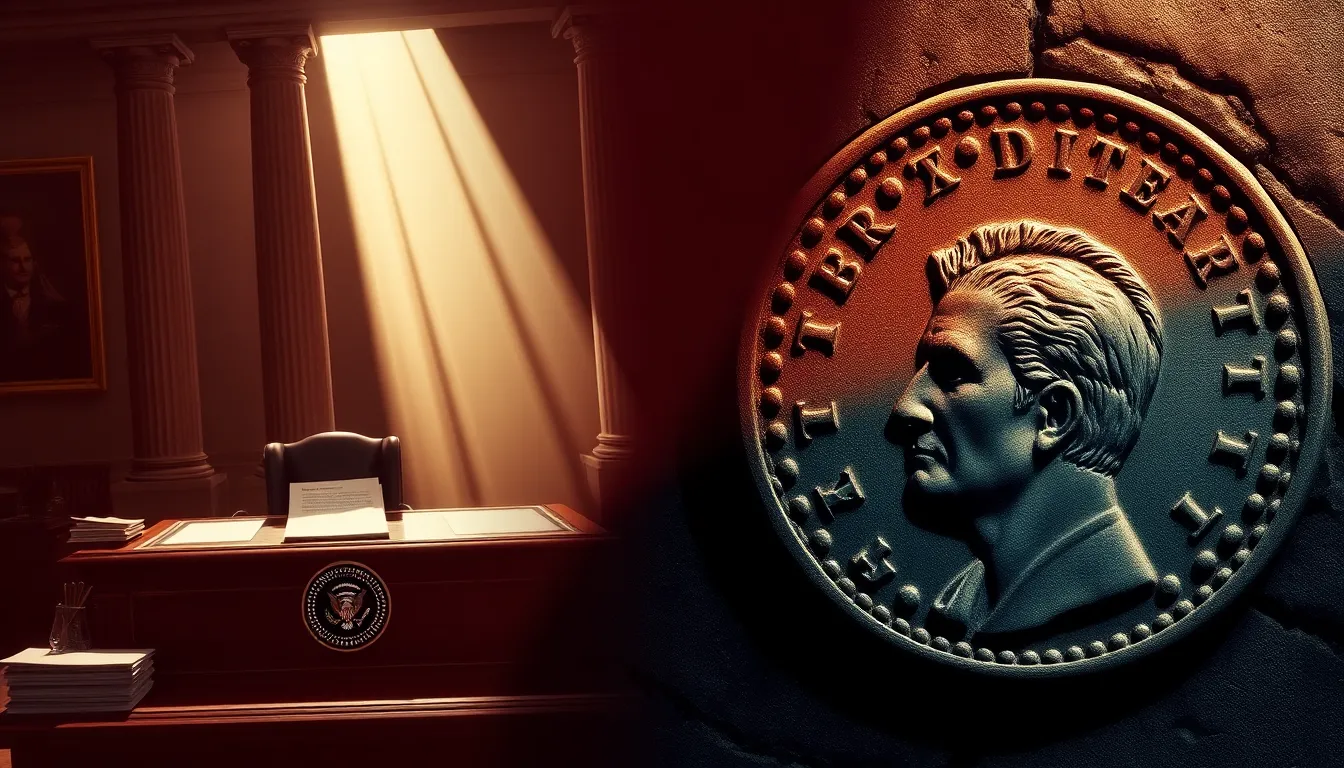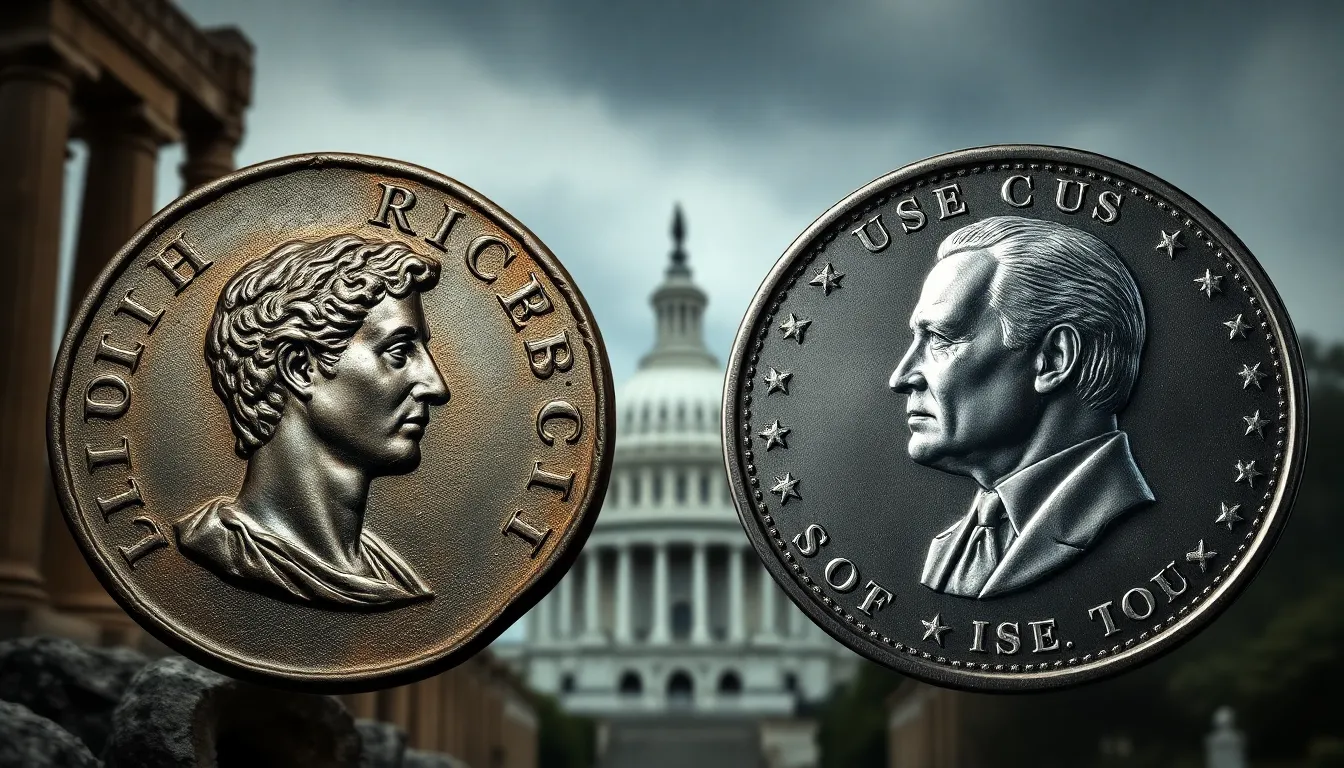Trump on a coin? When Julius Caesar tried that, the Roman republic crumbled soon after, highlighting how depicting living leaders on currency profoundly challenged centuries of tradition and heralded political upheaval. This historical precedent from Rome, alongside modern debates on executive power and US law, reveals currency’s potent role as a symbolic battleground for a nation’s identity and governance.
Symbolic Erosion of Republican Ideals:
The depiction of living figures on currency, initiated by Sulla and escalated by Caesar, shattered centuries of Roman numismatic tradition, visually asserting individual dominance and signaling a profound shift away from collective governance and republican values.
Quantifiable Concentration of Executive Power:
Both ancient Roman leaders, through extended terms like Sulla’s three-year dictatorship and Caesar’s consecutive consulships, and modern executives, via a surge in unilateral executive orders, demonstrate a measurable expansion of authority beyond traditional limits.
Challenges to Legal and Cultural Safeguards:
Current proposals for depicting living leaders on US currency directly confront explicit legal prohibitions and long-standing conventions, mirroring historical acts that undermined foundational republican principles and serving as potent indicators of political transitions.

500-Year Numismatic Tradition Shattered by Roman Leaders
The depiction of living figures on Roman coins marked a profound and unprecedented shift in the political landscape of the Republic. For over five centuries, since its establishment around 509 BCE, Roman coinage had adhered to a strict numismatic tradition, featuring only deities, mythological heroes, or allegorical representations. This long-standing convention underscored the republican ideals of collective governance and divine sanction, not individual power. The sanctity of this tradition began to unravel in the turbulent final century of the Republic, signaling a significant shift in political power dynamics that would ultimately lead to its demise. This historical precedent offers a compelling case study, reminding us of the profound symbolic weight currency can carry.
Sulla’s Precedent: The First Living Face on a Coin (82 BCE)
The first audacious challenge to Rome’s venerable coinage tradition came in 82 BCE with Lucius Cornelius Sulla. A ruthless general and statesman, Sulla became the first living Roman to have his portrait depicted on a coin. Specifically, his silver denarius, minted during his rise to absolute power, bore his unmistakable likeness. This act was a radical departure from established norms. Prior to Sulla, the Roman Republic’s coins served as public art, reinforcing shared civic virtues and religious beliefs. They were not tools for personal aggrandizement. Sulla’s decision to place his own image on currency was a bold, unprecedented assertion of individual authority, pushing the boundaries of what was acceptable within a republican framework.
This innovative use of coinage as a medium for personal propaganda was deeply symbolic. It visually broadcasted Sulla’s immense power and influence to every citizen handling the currency. The shift from divine or ancestral imagery to a contemporary, living leader’s face was not merely an aesthetic change; it represented a fundamental redefinition of the state’s relationship with its most powerful citizens. It paved the way for future leaders to further exploit this powerful medium. The break was undeniable, occurring after approximately 427 years of consistent republican practice. The historical lesson here is stark: changes in symbolic representation often precede or accompany monumental political upheaval.
Caesar’s Escalation: Dictator for Life on Currency (44 BCE)
While Sulla opened the door, Gaius Julius Caesar strode through it decisively, escalating the challenge to Roman numismatic tradition just months before his assassination in 44 BCE. Caesar, having consolidated immense power, issued coins that prominently displayed his bust. His coins went further than Sulla’s, explicitly featuring the words “dict perpetuo,” signifying “dictator for life.” This declaration on official currency left no ambiguity regarding his aspirations for perpetual authority, directly confronting the republican fear of single-person rule.
The timing of these coins was critically important. They appeared at the zenith of Caesar’s power, a public manifestation of his unassailable position. Placing his bust on coinage, alongside the powerful “dict perpetuo” inscription, was an act of extreme provocation to those who still cherished republican ideals. It underscored his ambition to transcend the traditional limits of political office. This move intensified the anxieties of senators and citizens who feared the Republic was irrevocably slipping into monarchy. Indeed, when Julius Caesar tried that, the Roman republic crumbled soon after, a chilling historical parallel that resonates even today. The striking imagery served as a clear message: Caesar was not merely a powerful figure; he was the embodiment of the state, a profound and dangerous shift for a republic.
The Symbolism of Decline: Coins as Harbingers of Change
The sequential defiance of numismatic tradition by Sulla and then Caesar correlated directly with the Roman Republic’s irreversible decline. Coins, as omnipresent instruments of daily commerce, also functioned as powerful tools of propaganda and cultural messaging. For centuries, they had reflected a shared Roman identity and commitment to republican values, where no single individual was elevated above the collective. The introduction of living rulers’ portraits shattered this foundational principle, visually asserting individual dominance over institutional tradition.
This transformation in coinage was a clear symptom of a deeper political malaise. It reflected the growing influence of powerful military leaders who commanded personal loyalties, often at the expense of allegiance to the Republic itself. The subtle, then blatant, embrace of personalized currency demonstrated how individual ambition could undermine centuries of established norms. The shift from collective symbols to personal images on coinage was not just a matter of design; it was a profound declaration of power and a deliberate erosion of republican identity. The question of a modern figure on currency, akin to “Trump on a coin?”, inevitably prompts historical reflection on how such actions often signal fundamental changes in a nation’s political fabric. These Roman examples serve as a potent reminder of the symbolic battles fought over the very image of authority. The Roman Republic’s eventual transition into an Empire was foreshadowed by these very numismatic innovations, indicating a definitive move away from republican ideals.

Modern Executive Power Surges Against Historic Term Limits
The idea of a leader’s image on currency often sparks debate, reminiscent of ancient precedents. The historical context, particularly when contemplating the question, “Trump on a coin? When Julius Caesar tried that, the Roman republic crumbled soon after,” highlights critical discussions about concentrated power. Both eras faced leaders who challenged established republican norms by extending their authority beyond conventional limits. This pattern is observable in the modern surge of executive power and ancient Roman political maneuvers.
The Modern Expansion of Executive Authority
A significant and quantifiable shift in modern executive power is evident in the differing use of executive orders. These directives, issued by the President, often bypass legislative processes, becoming a powerful tool for implementing policy. During Donald Trump’s presidency, he signed over 200 executive orders in less than nine months. This rapid deployment illustrates a substantial reliance on unilateral executive action to shape governmental operations and national policy.
In stark contrast, Joe Biden, throughout his entire presidency, issued 162 executive orders. This difference underlines a notable expansion in the frequency and scope of executive directives during the Trump administration’s early tenure. Such a surge in executive orders signals a move towards more centralized authority within the executive branch, diverging from traditional checks and balances. It reflects a growing tendency to implement agendas without extensive legislative negotiation.
Echoes from Ancient Rome: Sulla and Caesar
The concept of a leader extending their term beyond established limits is not new; ancient Rome offers compelling parallels. Lucius Cornelius Sulla, a Roman general and statesman, famously assumed the dictatorship in 82 BCE. Historically, a dictator was appointed only in times of extreme emergency, holding office for a maximum of six months. Sulla, however, held this extraordinary office for an unprecedented three years (82-79 BCE). This extended term fundamentally challenged the very foundation of the Roman Republic, demonstrating a powerful individual’s ability to override long-standing constitutional norms.
Similarly, Julius Caesar, another towering figure in Roman history, served as consul for three consecutive years (46-44 BCE). The consulship was traditionally a one-year term, with strict rules against immediate re-election to prevent any single individual from accumulating too much power. Caesar’s repeated consulships contravened this essential republican convention, eroding the spirit of shared governance. These actions by Sulla and Caesar serve as historical warnings when we consider phenomena like “Trump on a coin? When Julius Caesar tried that, the Roman republic crumbled soon after.” They demonstrate how the extension of a leader’s power, even through seemingly legal means, can undermine republican institutions.
Quantifying the Shift Towards Concentrated Authority
In both the ancient Roman and modern American contexts, these actions represent a quantifiable departure from established norms towards concentrated authority. The sheer volume of executive orders issued by Donald Trump in his initial months, exceeding Joe Biden’s total for his entire presidency, provides a tangible metric for this modern expansion of executive influence. This surge highlights a president’s increased ability to shape policy without direct legislative approval, consolidating power within the executive branch.
The Roman examples offer a stark historical reflection. Sulla’s dictatorship for three years, against a standard six-month emergency term, and Caesar’s three consecutive years as consul, defying the traditional one-year limit, were direct challenges to republican conventions. These extensions were not merely procedural irregularities; they were critical steps that destabilized the Roman Republic, ultimately contributing to its transformation into an empire. Both modern and ancient examples underscore how leaders, through different mechanisms, can push the boundaries of their roles, compelling societies to re-evaluate the resilience of their foundational institutions. The questions surrounding a leader’s image on currency or their use of executive power invariably prompt contemplation on the delicate balance of authority, especially when historical precedents warn that “Trump on a coin? When Julius Caesar tried that, the Roman republic crumbled soon after.”

US Law Challenged by Proposed Coin Depicting Living Figure
A draft proposal for a 2026 coin featuring Donald Trump has ignited significant debate, directly challenging a long-standing US legal prohibition. This initiative, intended to mark 250 years since the US Declaration of Independence, symbolizes a notable shift from established democratic principles. Such an action echoes historical precedents where similar moves, like those by Julius Caesar, preceded significant political upheaval and the crumble of republican systems. The very notion of Trump on a coin? When Julius Caesar tried that, the Roman republic crumbled soon after.
Current US law strictly prohibits the depiction of “the likeness of any living person” on its bonds, securities, notes, fractional or postal currency. This explicit legal framework serves as a safeguard, ensuring that national currency remains a symbol of collective governance rather than individual glorification. The law is designed to uphold republican values by preventing any single living figure from being elevated to a monarchical status through currency.
The proposed 2026 coin, featuring a living former president, directly confronts this foundational legal principle. Its timing, coinciding with a quarter-millennium milestone of American independence, adds another layer of complexity. The proposal forces a national conversation about the symbolic representation of power and the sanctity of legal conventions within a democratic republic.
Echoes of Ancient Rome: Caesar’s Precedent
To understand the profound implications, one must look to history, specifically to ancient Rome. In 44 BCE, Julius Caesar issued coins bearing his own likeness. While not a direct violation of a written law, this act was a striking defiance of a powerful Roman convention. Roman currency typically featured deities or abstract personifications of the state, not living individuals.
Caesar’s decision to place his image on coinage was widely interpreted as a blatant move towards monarchy and personal autocracy. It signified his intent to consolidate individual power above the traditional republican institutions. The symbolic weight of this action was immense, signaling a fundamental shift in the very nature of Roman governance. This bold act by Caesar immediately preceded his assassination and the ultimate breakdown of the Roman Republic, paving the way for the Roman Empire.
The historical parallel is stark: When Julius Caesar tried that, the Roman republic crumbled soon after. His actions with coinage were a clear indicator of a leader seeking to place himself above the collective identity of the state. This precedent underscores how symbolic gestures on currency can foretell significant political transitions and the erosion of republican ideals.
The Enduring Symbolism of Currency
Currency in a republic serves as more than just a medium of exchange; it is a powerful canvas for national identity and shared values. It typically celebrates historical figures, national monuments, or abstract concepts that bind a society together. The absence of living figures on US currency is a deliberate choice, reinforcing the idea that leadership is temporary and subservient to the nation’s enduring principles.
A proposed Trump on a coin, therefore, represents more than just a design choice; it is a direct challenge to the very definition of a democratic republic. Such an action could symbolize a shift from a system where leaders serve the state to one where the state is seen as embodying a particular leader. This move could be perceived as undermining the democratic ideal of temporary, elected representation.
Both instances – Caesar’s coinage and the proposed Trump coin – highlight how symbolic actions on currency are potent indicators. They can signal a profound shift from republican ideals towards autocratic principles. These aren’t trivial acts but rather highly charged political statements that question established conventions and legal frameworks safeguarding democratic governance. The very act of imprinting a living leader’s face on national tender carries historical weight and critical implications for a nation’s political identity.
Featured image generated using Flux AI
The Conversation: “Trump on a coin? When Julius Caesar tried that, the Roman republic crumbled soon after”
